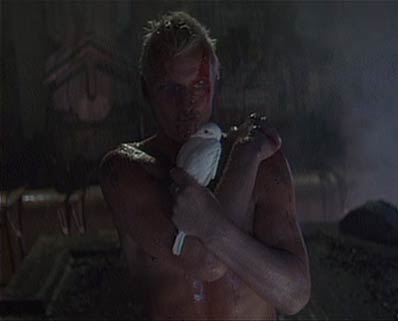Year: 1998
Directed by: Ryutaro Nakamura
Written by: Chiaki Konaka
IMDB Reference
Degree of Cyberpunk Visuals: High
Correlation to Cyberpunk Themes: Very High
Key Cast Members:
Lain Iwakura: Kaori Shimizu
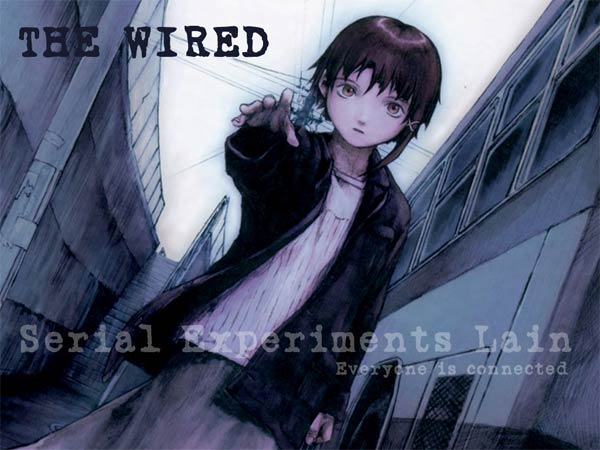
Overview: Serial Experiments Lain is a psychedelic, post-modern cyberpunk series that one wonders how the director ever managed to make. Lain centers on a very shy school girl who slowly begins to figure out that she is not what she seems to be. After getting a computer and connecting to the “wired,” something with is far more expansive than the internet, Lain begins to realize that she may not be human, and that truly, reality and the “self” is exists (or does not exist) on many different levels. As the story progresses, Lain “evolves” in terms of understanding what she is and her place in a very post-modern world. We also get many interesting side stories, including crime, teenage coming of age issues, and dastardly plots.
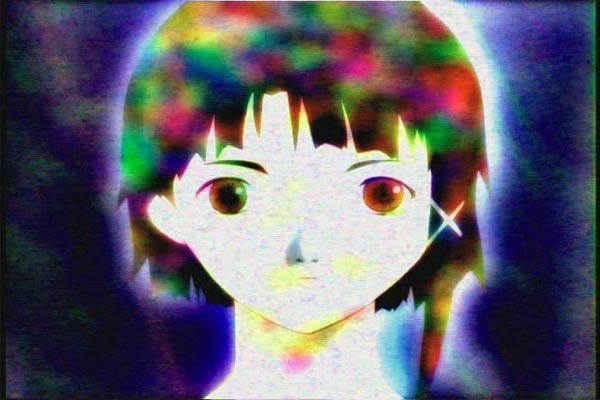
The pacing of Lain is just strange. Lain is NOT an action fest, nor is it by any means straight forward. Lain starts out rather slowly and gets weirder every episode. Truly, the story is told in a very “traditional” post-modern fashion in that we have fragmented vignettes structured in a seemingly random non-linear manner. Lain uses disconnected visuals to continually barrage the viewer with different textures, color schemes, and sounds. Yet over time, it becomes clear that the story is being spunk in seemingly a cyclical fashion, almost as if we are exploring a large Mandelbrot by starting at an outside spiral and slowly working our way around to the big picture. Each fragmented vignette gets added to until, at the end, we have a rather expansive tapestry to explore.
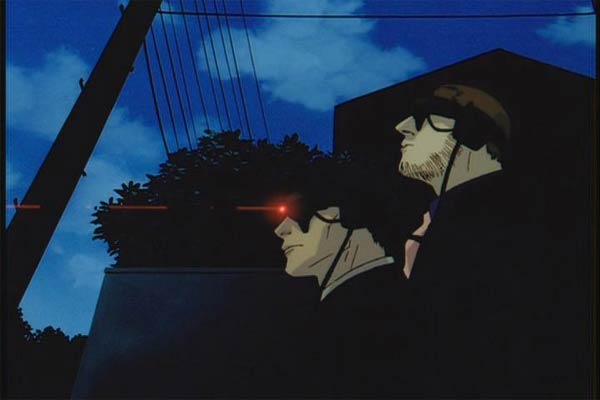
Many different and interesting philosophical ideas. But it is pure philosophical cyberpunk. Many key issues are discussed here, including:
- What constitutes “reality”?
- How real is time?
- What constitutes the “self” as a singular entity?
- What constitutes “God”?
- How are sentient programs different from humans?
- Is there such a thing as collective humanity?
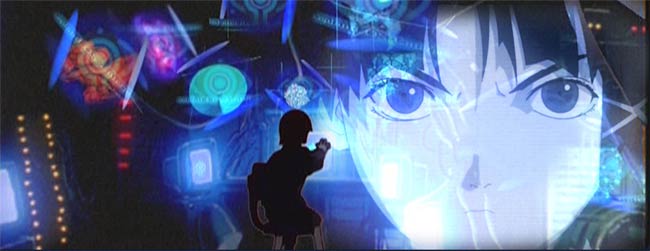
The visuals in Lain really aren’t there to “Wow” us as they are in some animes - instead they are often designed to provoke moods and thought patterns (BTW, there are so many screen caps available, that there was no need to take my own). Among the thought provoking visuals, we get:
- Psychedelic visions that explore multiple “selves” versus a singular “I”
- Juxtapositions of noise with false clarity
- Information Theory described visually
- An ever increasing feeling “disbelievability” each time the drab and normal school scene is shown.
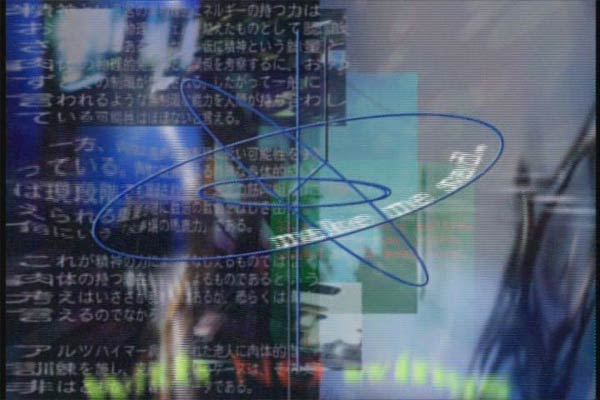
The Bottom Line: In the end, we are left with very open-ended thoughts. Serial Experiments Lain does not provide us with answers, instead, it opens us up to questions. And while I might argue that the post-modern pacing got too circular in places, and that I might argue the same tale could have been spun in half the time, the overall effect is rather extraordinary.
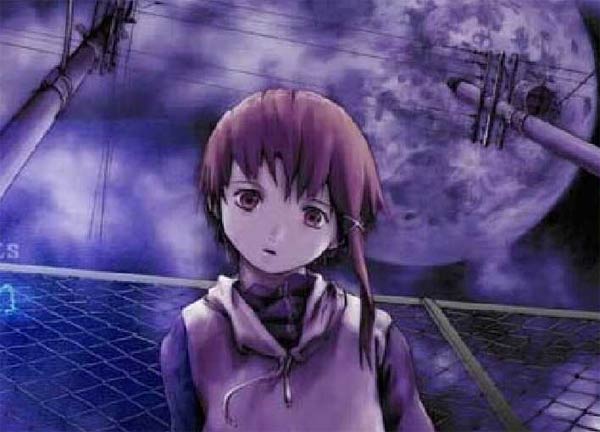
~See movies similar to this one~
Tags: cyberpunk movie review anime Serial Experiments Lain
Year: 1995
Directed by: Terry Gilliam
Written by: Chris Marker, David & Janet Peoples (screenplay),
IMDB Reference
Degree of Cyberpunk Visuals: Very High
Correlation to Cyberpunk Themes: Very High
Key Cast Members:
James Cole: Bruce Willis
Kathryn Railly: Madeleine Stowe
Jeffrey Goines: Brad Pitt
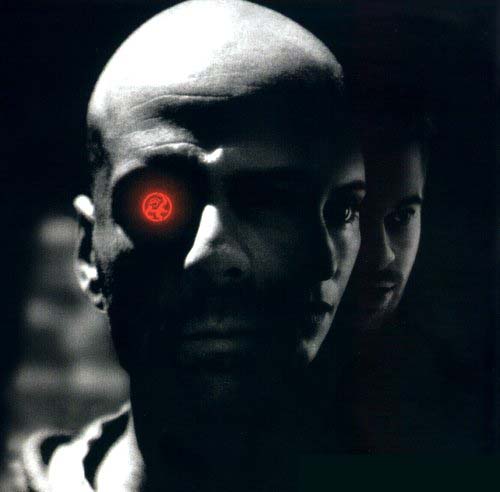
Overview:Twelve Monkeys is yet another tour-de-force from film maker Terry Gilliam. Done as a remake to the very innovative experimental French film, La Jetée, Gilliam is able to take the same notions of time travel, dystopic futures and personal trauma and love, and wrap it into a truly riviting package.
Because of the similarities, I have reviewed this movie in-depth in combination with La Jetée (these two movies truly go together). Please check it out:
~See movies similar to this one~
Tags: cyberpunk movie review
Year: 1962
Directed by: Chris Marker
Written by: Chris Marker
IMDB Reference
Degree of Cyberpunk Visuals: High
Correlation to Cyberpunk Themes: Very High
Key Cast Members:
Narrator: Jean Négroni
The Man: Davos Hanich
The Woman: Hélène Chatelain
The Experimenter: Jacques Ledoux

Overview:La Jetée as a movie is one of the most interesting I’ve encountered. Virtually the whole movie involves narrating still shots. While this sounds like a glorified slideshow, its anything but. The pacing is magnificent. The mood created is truly immersive. In a truly astounding feat, Marker traps the viewer in this "slide show" mentality, and then, as the movie is discussing whether the character can decipher what’s real or not, he pulls the run out from under us.
I have reviewed this movie in-depth in combination with 12 Monkeys (these two movies truly go together). Please check it out:
~See movies similar to this one~
Tags: cyberpunk movie review
Year: 1995
Directed by: Robert Longo
Written by: William Gibson (short story, screenplay)
IMDB Reference
Degree of Cyberpunk Visuals: High
Correlation to Cyberpunk Themes: Very High
Key Cast Members:
Johnny Mnemonic: Keanu Reeves
Jane: Dina Meyer
J-Bone: Ice-T
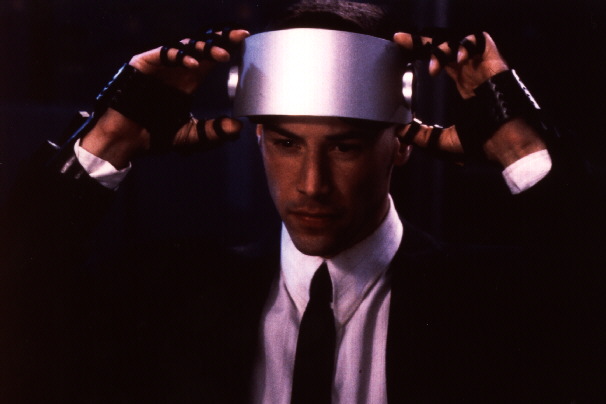
Listen. You listen to me. You see that city over there? THAT’S where I’m supposed to be. Not down here with the dogs, and the garbage, and the fucking last month’s newspapers blowing *back* and *forth*. I’ve had it with them, I’ve had it with you, I’ve had it with ALL THIS —
I WANT ROOM SERVICE!!! I want the club sandwich, I want the cold Mexican beer,
I want a $10,000-a-night hooker. I want my shirts laundered…like they do…
at the Imperial Hotel…in Tokyo.

Overview: Johnny Mnemonic has always been a guilty pleasure of mine. Yes, this movie has problems, not the least of which is having a name that I can never remember how to spell, but overall, this movie is just pure cyberpunk fun! Johnny Mnemonic has a terrific mix of “punk” and “cyber” although it definitely strays to the “punk” side of things. He we have corporate domination, punk rebellion, modified humans (and dolphins!), dystopian societies and all the rest, all wrapped up in some wonderfully inspired William Gibson visuals.
Johnny (played by cyberpunk zen master, Keanu Reeves) is a data courier who deals in somewhat shady and dangerous clients in need of data getting discretely transferred to another location. He has gotten a large chunk of his long term memory removed in order to have enough space to put a massive hard drive inside his head. Unfortuantely, his space isn’t large enough for his newest high paying customer, but he still takes the assignment even though there’s danger of data seepege into the brain. During the “transfer,” all hell breaks loose, with guns and bullets flying everywhere. Johnny is forced to flee, and eventually hooks up with a damaged bodygaurd played by Dina Meyer. Together they attempt to deliver the data from China to New Jersey, but unfortunately, SERIOUS complications arise when they find out what Johnny is actually holding in his head. Ice Tea and Takeshi Kitano also have notable roles in this flick.
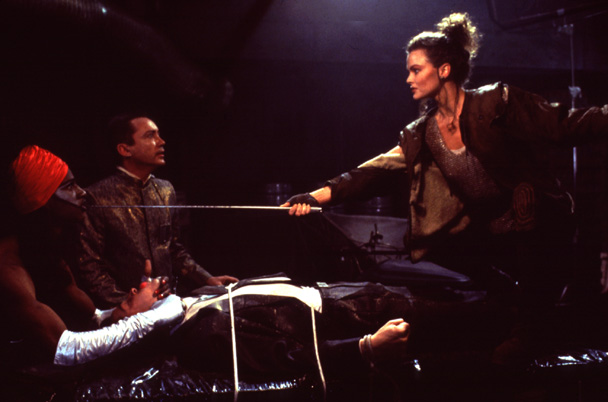
The Bottom Line: Johnny M., while mostly a scifi thriller, has some terrific lines. For anyone who’s seen this, you will remember the “I want room service” scene. I still love that! While I can’t argue that this is a great movie, I do really enjoy it. Still, it clearly could have been better. But at least this is contrasted with a few really fun scenes.
~See movies similar to this one~
Tags: cyberpunk movie review
Year: 2003
Directed by: Byung-chun Min
Written by: Byung-chun Min
IMDB Reference
Degree of Cyberpunk Visuals: Very High
Correlation to Cyberpunk Themes: Very High
Key Cast Members:
R: Ji-tae Yu
Ria: Rin Seo
Cyon: Jae-un Lee
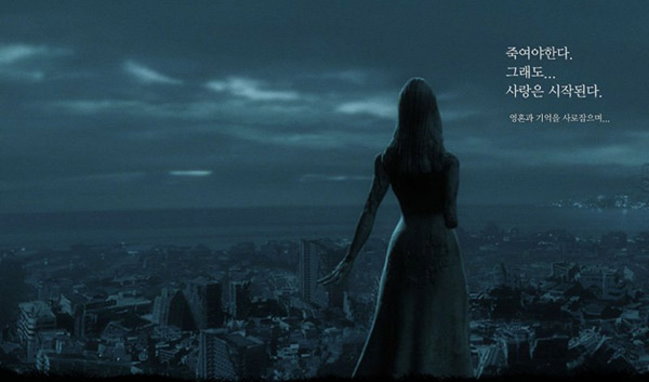
Overview: Natural City is a high priced attempt by the Korean movie industry to break into the Scifi Genre. The quality of the effects in Natural City clearly shine, both in the absolutely terrific set pieces, the painted backgrounds and the very realistic future setting. This is a cyberpunk movie to its core, with every possible aspect of cyberpunkness oozing from every pore of this movie. We get cyborgs, genetically engineered and cybernetically enhanced people, dominating corporations, theft and greed, seedy underground people and scenes, information access issues, and MASSIVE cyberpunk style. But truly, the reason Natural City rates this high is the absolutely wonderful cyborg character study in exploring issues of humanity.

The Setting: Natural City as a title is 180 degrees from what you get in a setting - nothing is real here. In this dystopian setting, genetic engineering and cyborg development have become an accepted way of life. Pretty much everyone in this city lives a miserable existence, in fact, its expected that life is pain. Vacations are taken in the equivalent of a Star Trek Holodeck type machine. The ultimate dream of everyone in this city is to become rich enough to retire to a floating hotel called Muyoga (see the picture immediately below), which advertises that it can erase your current memory and place you in a "virtual" life of your own choosing. This is extremely interesting, especially when compared to Oshii’s Avalon, in which one view of the the "ultimate" life is one where you are in a simulated reality of your own mind even though your body is a slobbering mess in the "real" world.
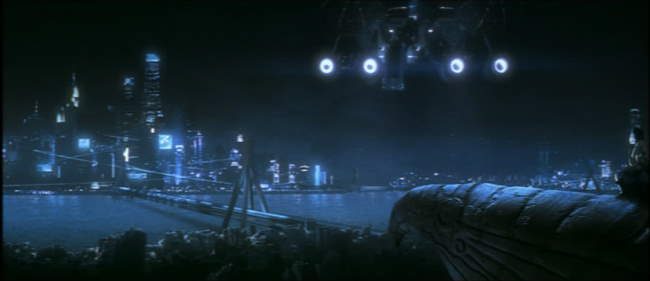
In Natural City, Cyborgs perform a myriad of societal functions - everything from entertainment and dancing, to restaurant helpers to working on the police force. To perform all these functions effectively, Cyborgs have a degree of self-awareness. This causes significant complications when their expiration date nears, as they know what it means to "expire." While some of the characteristics seem vaguely familiar to another far more famous cyberpunk movie (cyborgs with expiration dates, for instance), the story itself is radically different.
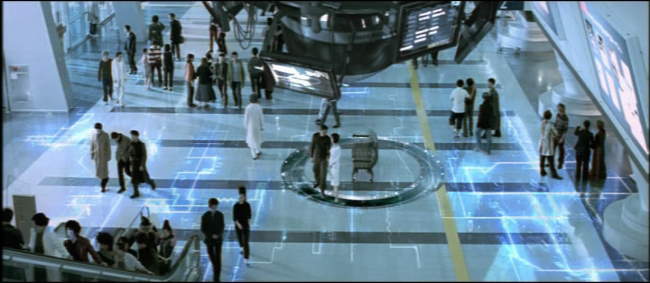
The Story: Natural City centers on the internal struggles of a highly talented cop named "R." He is tasked with finding and capturing renegade cyborgs, but ends up falling in love with a cyborg dancer named Ria who’s expiration date is only 3 days off. The movie centers on R’s compromising his principles and dealing with the cyborg underworld in a vain attempt to find a way to save his Ria. He finds a shady cyborg doctor who promises that if he finds a person with the right genetic match, he can inject part of their brain cells into Ria, which will save her. The doctor finds such a match in a street girl named Cyon.
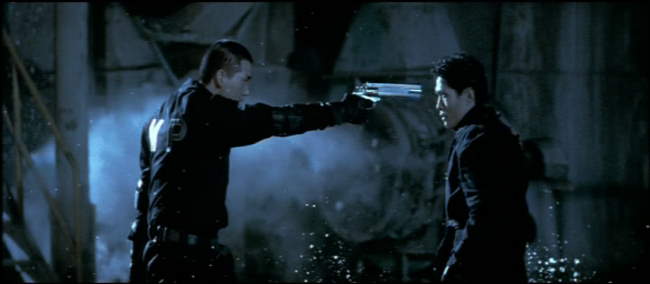
Complicating matters, R’s best friend Croy, who is also his boss and fellow police detective, has discovered his duplicity. During a raid to capture some renegade warrior cyborgs, Croy notices that R is not shooting them in the head (which kills them be wiping out their AI chip), but is instead going back later and collecting the AI chips to sell for money. Croy tracks R back to the shady doctor. Worse, one of the warrior cyborgs who escaped is also after Cyon for reasons that become all too apparent as the movie unwinds.
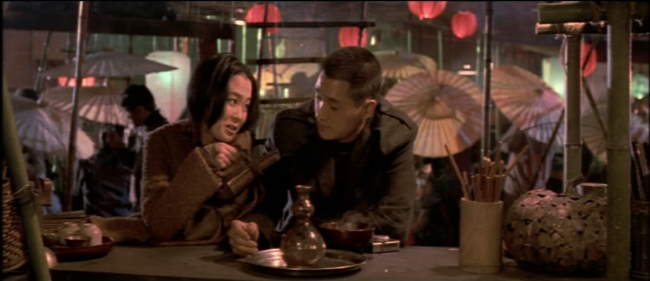
The Look: Natural City’s atmosphere is a grimy, lived-in futuristic environment. In some of the police scenes, Natural City comes across like a live-action Jin Roh movie (Jin Roh is definitely an influence for the action visuals). The high-quality and very original Scifi set pieces and occasional CG fits wonderfully, and along with the artistic backgrounds add up to a very immersive experience. The surround sound is not stunning, but is certainly decent and doesn’t detract from the experience. On top of this we get some wonderfully symbolic visuals, such as when Cyon sits atop a stone eagle statue, dreaming of life on the virtual hotel.
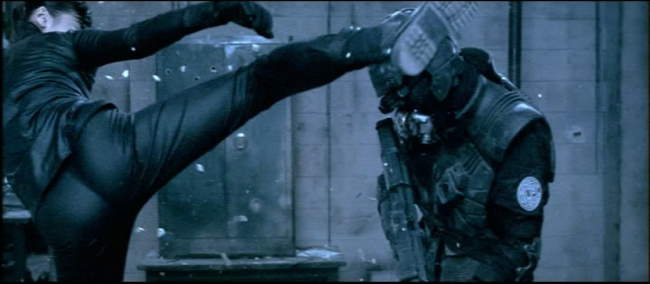
The Colors: Like most cyberpunk movies, Natural City uses one dominating color palette for the majority of the scenes. Blue is the color of choice, but varies from ultra-light to dark and dense blues. The lighter scenes usually depict high-tech human aspirations, whereas the darker scenes are left for massive action shots and for shots depicting the destruction of humanity, such as the gritty cyborg replacement lab. Every so often, we also get some really nice oranges and browns, but these colors are usually used more as chapter transitions.
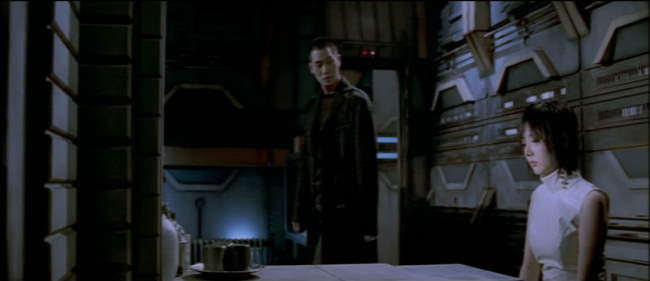
The Action: Natural City is a character exploration first, but the action and effects are on display, and in high quality. The action involves both slo-mo and high speed camera shots, along with LOTS and LOTS of blood and gore. The ending especially is somewhat of a gorefest, which is weird to see in a movie that is mostly a drama in nature. Also, near the end of the movie, we get treated to an evil, but ultra-hot cyborg warrior chick in skin tight lycra who engages in some major ass-kicking (see above for a pic of HER ass while kicking someone!). Talk about a plus! While we’re on the subject, we also get treated to some cute asian cyborg boobies at the beginning of Natural City - definitely a nice way to start the pic! (although, when you understand what the beginning boobie scene signifies it sorta takes away the fun).
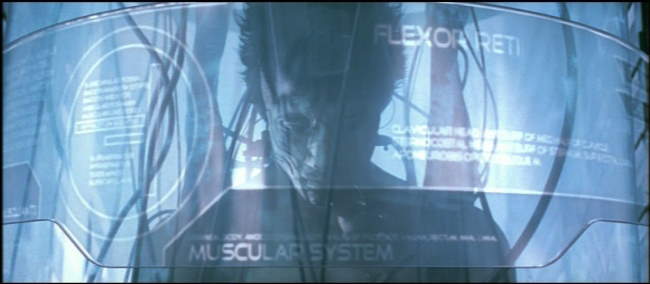
The Pacing: As I mentioned earlier, this IS a Korean movie. My wife is Korean, so I’m somewhat used to the pacing we see here. From reading a few reviews, Natural City has been panned for being way too slow and plodding in the middle. All I can say is, "Welcome to Korean Cinema." This is really a case where story telling is just different there. For a Korean, this movie is not at all slow, but has rather standard pacing, which means we get REAL in-depth and repeated scenes with the purpose of mood and detailed character study. Most important for Koreans is to be able to identify with the emotion and mood the characters are experiencing. Natural City takes the time to do this with all the main characters.
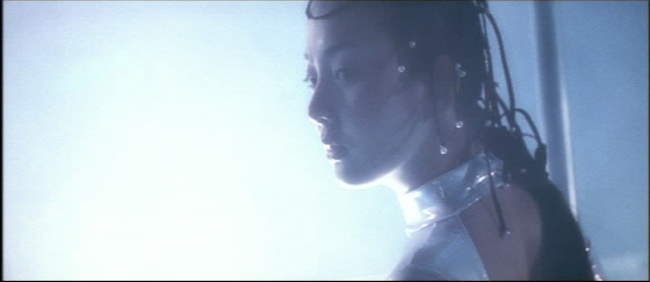
The characters really build in believability and engagement as the story progresses. At the beginning, R appears quite shallow, as does his friend and the street girl Cyon. By the end, all three, and especially Ria, his cyborg lover grow to be characters you really empathize with. The motivations for all become clear, including their virtues and flaws. The ending is also a rather "normal" Korean dramatic love story ending, which is to say, one very different from how an American film might end. Its not a feel-good movie, but then again, few Korean dramas are.
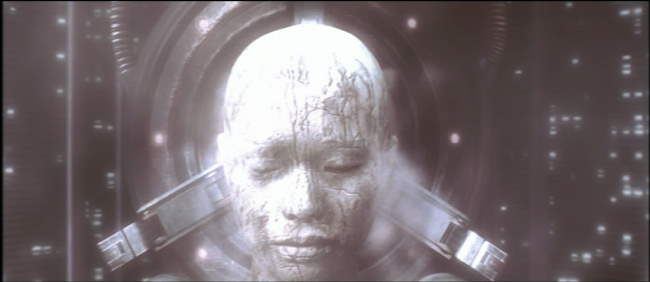
For me, the highlight of Natural City centered on Ria, the cyborg. To me, Ria captures the cyborg struggle for humanity better than any character in all cyberpunk movies save one scene (the Blade Runner’ sRoy Batty "I’ve seen things you wouldn’t believe" soliloquy, of course). While I didn’t catch this the first time through, the very beginning of the movie is told from Ria’s perspective, and then really, the last third of the movie centers on Ria (minus the action sub-plots). There are a few scenes that make it clear she "knows" what’s happening to her. She is programmed to be a dancer, but as she reaches her expiration date, she no longer can do this well. In one scene, Cyon shows her the "1 day" notice that arrives in the "Fifth Element" style mail slot. As her "time" approaches, you really do get the feeling of the Rutger Hauer speech at the end of Blade Runner, although Ria conveys this sentiment more broadly over a number of scenes and images. I want to go into this further, but this starts coming off as a spoiler, so I’ve added a more elaborative discussion of Ria’s motivations (spoilers) after the screencaps on Page 2.
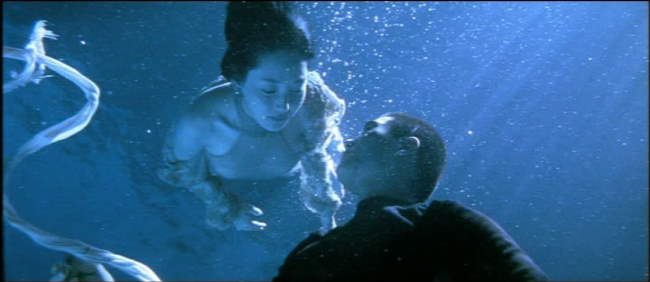
The Bottom Line: If you like cyberpunk films, the visuals alone make this a MUST SEE. If you like character studies in science fiction settings, you probably also want to see this. I truly LOVE Natural City, but be warned, the pacing is different from what you might expect. This is a Korean movie, and certainly plays like one. Also, be warned - like Wonderful Days, the ending has standard Korean Melodrama type stuff. While some might argue this doesn’t belong in the top 10, for me there’s no doubt that it does. The action and visuals are great, but Ria’s story clearly forces it there if nothing else.
Page 2: More Screen Caps and Ria’s Motivations Discussion (Spoiler)–>>
~See movies similar to this one~
Tags: cyberpunk movie review
Year: 1990
Directed by: Richard Stanley
Written by: Steve MacManus, Kevin O’Neill, Richard Stanley & Michael Fallon
IMDB Reference
Degree of Cyberpunk Visuals: High
Correlation to Cyberpunk Themes: High
Key Cast Members:
Jill: Stacey Travis
Moses Baxter: Dylan McDermott
Overview: Of all the movies I uncovered during my research for this list, Hardware far and above tops the list of movies I previously had no knowledge of. Put simply, Hardware is absolutely AWESOME low budget cinema. This cross between Alien and the Terminator is set in a totally weird cyberpunk dystopia. It’s scary as shit, it’s totally weird, and DAMN it’s good!
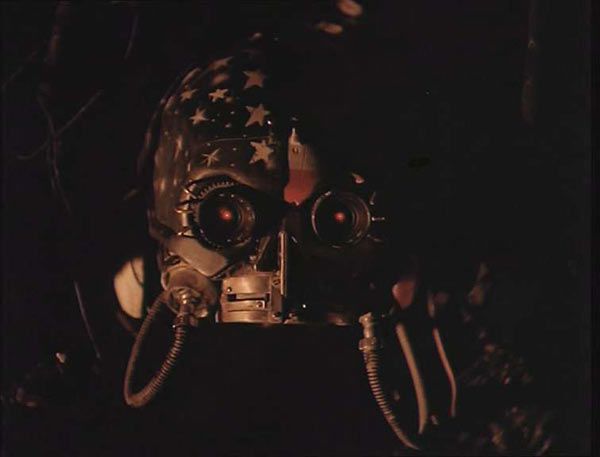
Filmed for only one million dollars, Hardware takes place in a truly bizarre dystopic future where a nomadic "parts" scavenger goes into a barren wasteland called the "zone" and finds a strange and seemingly valuable robot head and body parts. Through unfortuitous circumstances, this head finds its way back to a hot looking babe named Jill, an artsy-fartsy type (played wonderfully by Stacey Travis) who accepts it as a gift. She decorates the head with cool colors and stuff and sticks it on her shelf.
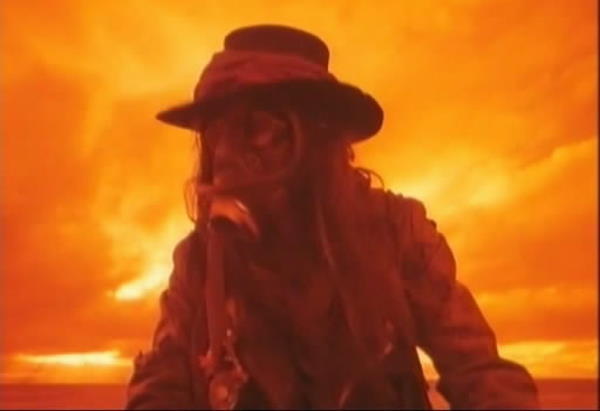
Unfortunately for her, it turns out this head and body parts make up the bulk of the government’s new prototype Mark-13 droid - a true killer designed to weed out excess population, that’s impervious to almost everything. Once this thing re-assembles itself, this thing begins its killing spree. On top of this, Hardware has some of the most eclectic collection of characters ever assembled. We have a totally slimy pervert that spends his time peeking in on Jill, especially when she’s in the nude; we have a completely shady parts dealer, we have a zen-like unknown nomad, we have a completely weird boyfriend’s sidekick, and some truly bizarre apartment tenants.
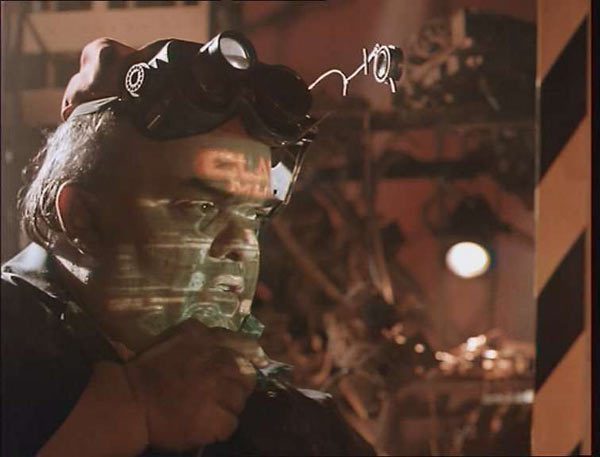
The Visuals: Like most cyberpunk films, there is one color that dominates the screen - in this case its orange. We get orange EVERYWHERE, along with a nice few accents of pale yellow. All the set pieces are totally futuristic and hip. We get fun advertisements on the radio, a totally hip atmosphere, and truly, one of the best soundtracks found in movies. Quite simply, Hardware ROCKS!
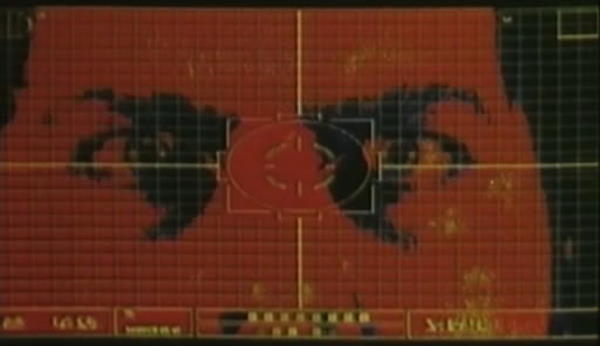
Now for the bad news - unless you’re in region 2, you’re screwed. I picked up a used VHS for about 17 bucks on ebay but still found it worth it. Unfortunately, this version is panned and scanned and cut. If I had obtained a "real" version of this movie, no doubt it would be sitting in my top 10.
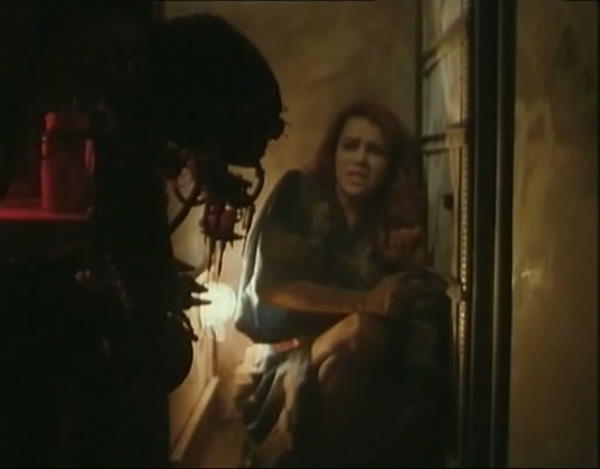
The Bottom Line: Hardware is a terrific, low-budget cyberpunk flick - one of the best low budget cyberpunk movies ever. If you are looking for a great, futuristic terminator-style chase movie that takes place almost completely in a bizarre apartment building, this is your movie!
~See movies similar to this one~
Tags: cyberpunk movie review Hardware
Year: 2003
Directed by: Hiroshi Hamazaki
Written by: Chiaki Konaka
IMDB Reference
Degree of Cyberpunk Visuals: Very High
Correlation to Cyberpunk Themes: Very High
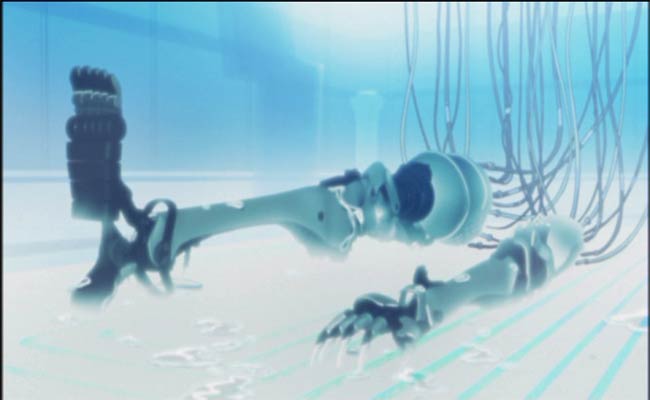
Overview: Written by one of the most prolific anime writers, Chiaki Konaka (Who also wrote Lain, Malice@Doll, Hellsing, Bubblegum Crises, etc.), Technolyze is a virtual feast of visuals wrapped up in a Lain-style fragmented cyberpunk gangster story. Like Lain, the beginning is almost non-sensical, but creates the foundation for the mood of the rest of the story.

Texhnolyze is the name for the technology to make fully integrated cybernetic limbs like those above. The story follows Ichise, a former down-and-out boxer living in Luckass, a truly disturbed city with the elite rich side and the poor slums. Ichise inadvertently crosses the local mafia (called the Organo), and ends up getting an arm and leg chopped off. But luck would have it that he’s a perfect candidate for a hot chick Texhnolyze’s doctor’s experiments in the latest Texhnolyze research. Ichise carries around a capsule containing his dead mother’s body cells, which the doctor integrates into the limbs. Ichise spends many episodes figuring out how to get revenge for how he changed, but based on discussions with a girl who can see the future, his motivations change as the series moves forward.
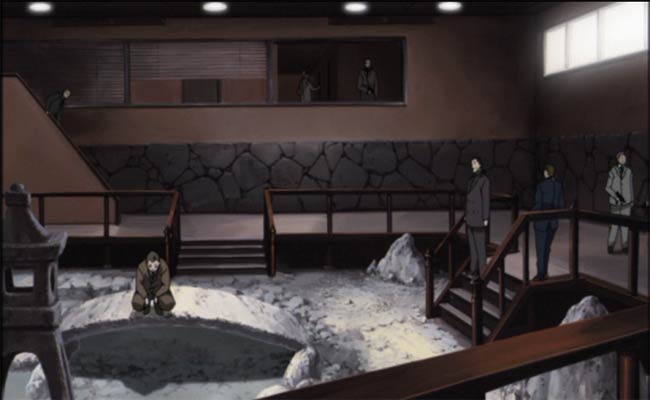
This is NOT a kids story. Every episode has LOTS of gangster-like killings. We get lots of guns and a few cool sword fights. We also get some nice Texhnolyze deaths with fists going through faces. Truly, this might be described as Goodfellas meets Serial Experiments Lain. And while I haven’t gotten the last DVD set, I’m guessing this is is NOT going to be an uplifting story.
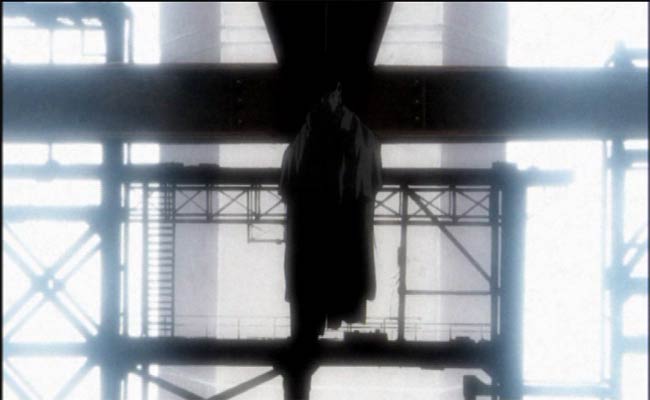
The Visuals: Unlike Lain, Texhnolyze is as Neo-noir as they come. The use of shadows is amazing. We get lots of stark white on blacks, interesting gray patterns, and lots of yellows and browns. Also, virtually every character is flawed and mysterious. While the anime is truly riveting, you won’t find yourself becoming attached to anyone. The characters simply aren’t sympathetic.
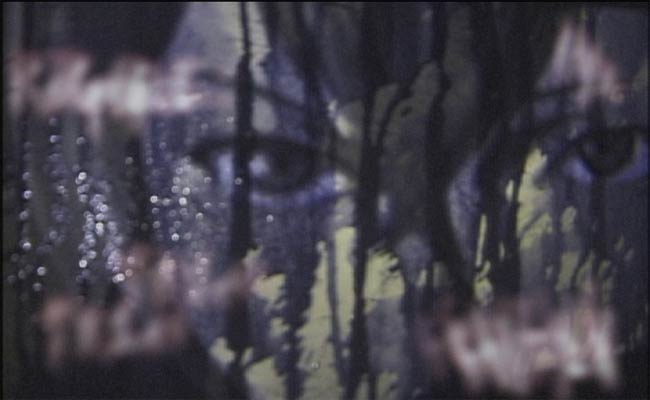
Texhnolyze is a virtual feast of visual textures and palettes. Whenever you look through a texhnolyzed person’s eyes in first person, you see almost a terminator-like display, only the screen is filled with noise. We also get the most incredibly detailed background sets. Truly, you feel like you know this city after watching a few DVDs worth of this. We also get great camera angles, with sweeping shots, extreme close-ups intermixed with psychedelic-like image merges. Top this with a terrific score and wonderful surround sound, and the WOW effect hits you in total.
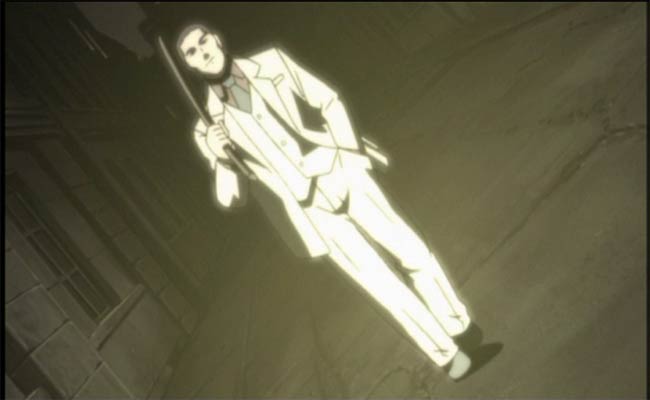
The Bottom Line: Truly, its clear that the creators of Texhnolyze wanted to make something as overtly cyberpunk as possible. They truly have succeeded. Texhnolyze is not for everyone, as the story is violent, obscure, and cold. It is however, a truly awesome and totally original cyberpunk series!
~See movies similar to this one~
Tags: cyberpunk movie review anime Texhnolyze
Year: 1982
Directed by: Ridley Scott
Written by: Philip K. Dick (Novel), Hampton Fancher & David Peoples
IMDB Reference
Degree of Cyberpunk Visuals: Very High
Correlation to Cyberpunk Themes: Very High
Key Cast Members:
Rick Deckard: Harrison Ford
Roy Batty: Rutger Hauer
Rachael: Sean Young
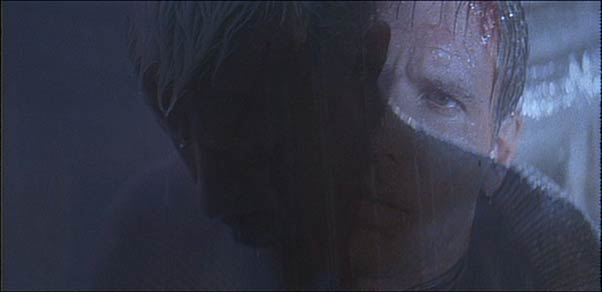
I’ve seen things you people wouldn’t believe. Attack ships on fire off the shoulder of Orion. I watched C-beams glitter in the dark near the Tannhauser gate. All those moments will be lost in time, like tears in rain. Time to die…
Overview: If you read a lot of the reviews from others about movies on this site, you’ll find that over half of them reference Blade Runner in some way, other in the visuals or issues discussed. Along with Gibson’s Neuromancer, Blade Runner did more to establish cyberpunk as a genre. The fact that Blade Runner came two years prior to Neuromancer is rather interesting. Truly, this film set the standard for the near-future film noirs sub-genre we call cyberpunk.
Not too dissimilar to the wrath that greeted Metropolis’ release, Blade Runner was not an instant hit. Instead it grew from being critically panned to a cult classic, to now, where its well on its way to being considered a timeless classic.
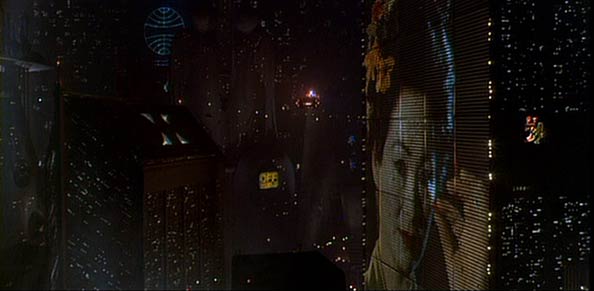
Commerce is our goal here at Tyrell. More human than human is our motto
The Visuals: The visuals in Blade Runner are simply stunning. We see corporate pharaohs ruling a society containing manufactured slaves from their Egyptian style pyramids, while we see rot and decay on the streets below. Noir-style beige and blacks dominate the screen, but are often supplanted by shocking neons. In Blade Runner, we see and Earth in ruin - a place that people are eager to leave. Only the poor and problematic are left on this rain-soaked dystopian planet that has been raped of any semblance of natural existence. The Earth is now almost completely devoid of trees and animals, which are now replaced with artificial ones for the pleasure of mankind.
The Story: Technology and corporate power are clearly the cause for this downfall. Genetic engineering has run rampant, and is combined with advanced organic computing technologies. It is in this world that we find a cast of flawed characters. Nobody is pure, nobody pristine. They are all a product of the environment they live in.
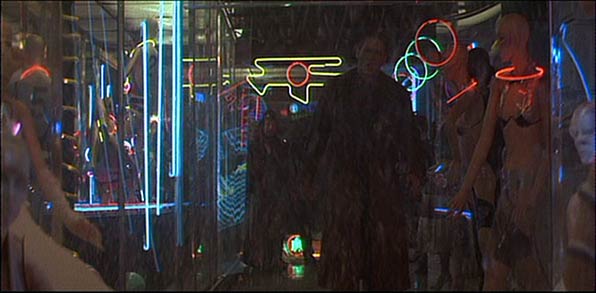
Replicants are like any other machine - they’re either a benefit or a hazard. If they’re a benefit, it’s not my problem.
To augment humanity’s needs and desires, replicants, or genetically engineered humans imbued with artificial intelligence have been developed. They serve many important roles including protection, pleasure slaves, and hard labor for the most dangerous environments. While replicants start out as rather straightforward and useful machines, over time, they start to develop awareness - their own personality, and eventually, free will and a desire for self-preservation. Because they are defined as property, Replicants are given a 4-year lifespan, which is enforced upon inception, and is irreversible.
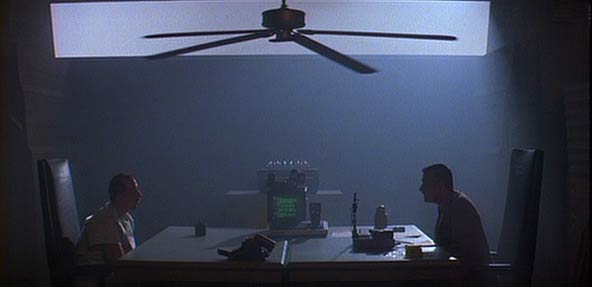
My mother? Let me tell you about my mother!
It is in this world that we encounter Deckard (Harrison Ford), a Blade Runner. Blade Runners are cops who hunt down Replicants. At the beginning of the movie, we find that Deckard has supposedly retired from the business.I say supposedly here, because if he is a replicant, then really, he has been imbued with false memories as well, and in fact has never been a blade runner prior to this. Really, he is just filling in as a laborer fulfilling another job that is too dangerous for humans.
Deckard is brought back in to "retire" 4 runaway "skin jobs" (replicants) who have murdered humans off-world and have escaped to Earth. Apparently, they seem to be interested in coming back to their creators - the Tyrell corporation. The story expands from there, and truly touches on some wonderful questions concerning ethical dilemmas that most certainly will arise in the future.
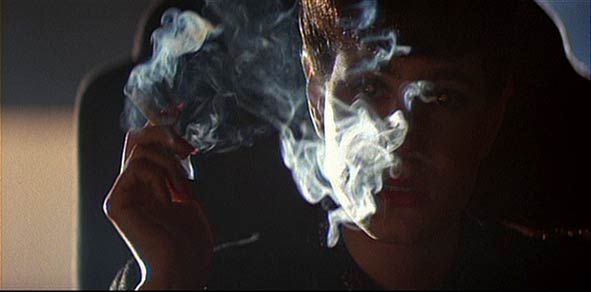
Are these questions testing whether I’m a replicant or a lesbian, Mr. Deckard?
I’m not in the business. I AM the business… Deckard encounters Rachael (played wonderfully by Sean Young), a replicant who during the movie discovers her true nature. Blade Runner does a masterful job of exploring the questions and emotions surrounding this. We see Rachael’s theme echoed in Natural City, Armitage, Thirteenth Floor, Ghost in the Shell, Serial Experiments Lain, Malice@Doll, the Animatrix, I, Robot, and others. This question about what degree artificial life forms are human is a central theme of the cyberpunk genre.
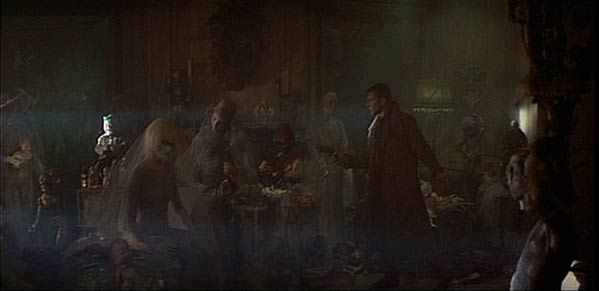
What is Human? While other movies have been terrific in exploring this, Blade Runner still sits at the top of the list, both for Racheal, and for Roy Batty, the leader of the renegade replicants. Roy’s monologue near the end (see the quote at the top), which was supposedly adlibbed by Rutger Hauer, captures in a single moment the ethical dilemma with creating sentient life. If they have freewill, can they really be considered property? And if they aren’t property, what are they, exactly?
Blade Runner uses mannequins and toys as its set piece for representing this dilemma. In Blade Runner, corporations create these glorified toys - moving mannequins if you will, to meet the needs of society, yet while the toys themselves are clearly a product of the society just like all the other noir characters, are they truly nothing more? And if we do consider them to be on par with humans, what obligations do they have to their creators, who invested time and money in their creation?
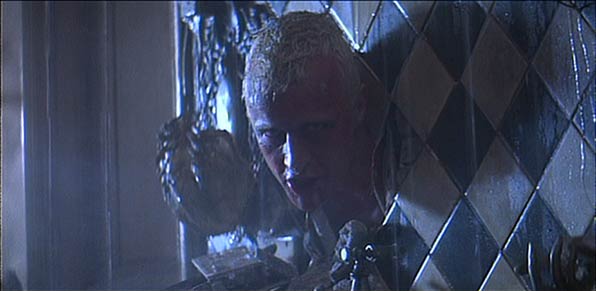
The light that burns twice as bright burns half as long - and you have burned so very, very brightly, Roy.
The Bottom Line: On top of all this philosophical questioning, we get some great noir-detective-like action and suspense. Roy Batty is truly a badass. Deckard’s pursuit of him is a very fun engagement, as is the climax. Its flat out terrific. The pacing is wonderful, the visuals are astounding, and the story is enthralling. By now I’m guessing most have seen this cinematic masterpiece, but if not, you are truly in for feast!
Page 2 - More Screen Captures–>>
~See movies similar to this one~
Tags: cyberpunk movie review
Year: 1988
Directed by: Shinya Tsukamoto
Written by: Shinya Tsukamoto
IMDB Reference
Degree of Cyberpunk Visuals: Very High
Correlation to Cyberpunk Themes: Very High
Rating: 10 out of 10
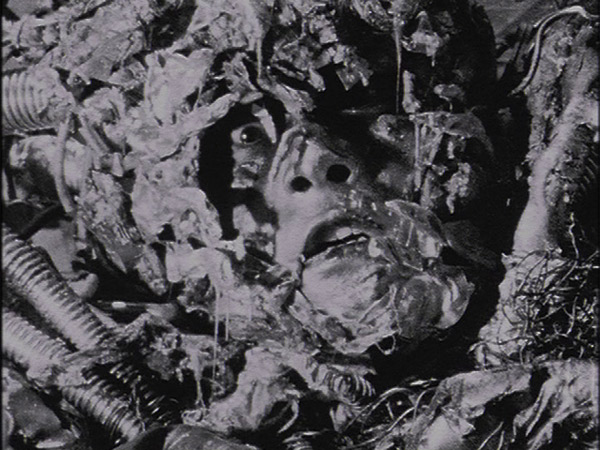
Overview: For another movie that taps out the weird shitometer scale, and the pinnacle of Japanese cyberpunk flicks, Tetsuo is simply terrific! I must warn you that this movie is NOT for everyone. We get a bevy of disturbing images, including extreme body manipulation, anal rape of a guy by a mechanically "enhanced" female, rape in the reverse by a man with a literal "power tool," and truly the most bizarre set of images one can imagine. But in all this, there are some truly interesting messages that emerge. Unlike other Japanese Cyberpunk films such as Rubber’s Lover, which is more of a one track film (extreme situations to prompt greater than human abilities), Testsuo provides a wonderful commentary on the direction of mankind.
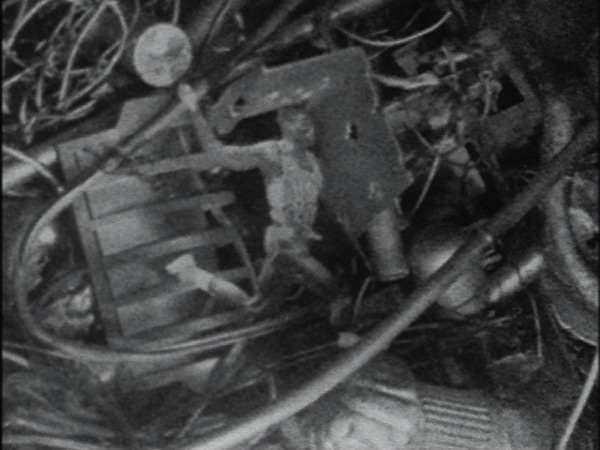
This is one of the best opening symbols for any movie I can remember. It sums up Tsukamoto’s message perfectly!
Tetsuo’s Message: While Tetsuo is a really bizarre, low budget, surrealist underground Japanese cyberpunk movie, it has a number of interesting themes running through it. On a societal level, Tetsuo explores how man’s technological dash to the future has resulted in an acute fear of technology, and that its ever encroaching progress is destroying our humanity. This is symbolically represented by a runner surrounded by scrap metal, and then later, a man in running gear who’s slowly being taken over by machinery when competing with another machine man.
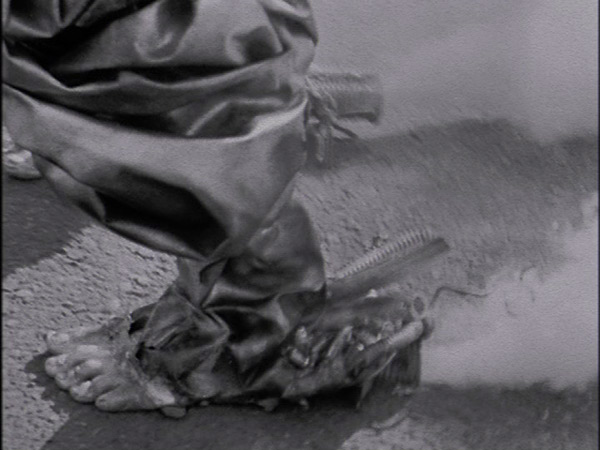
The clear message at the end is that by constantly competing with one another in our strive for perfection in an orderly society, we are destroying humanity at its core. Technology is our tool of choice for this destructive competition. The shot of the augmented foot above really captures this well, as does the race scene below.
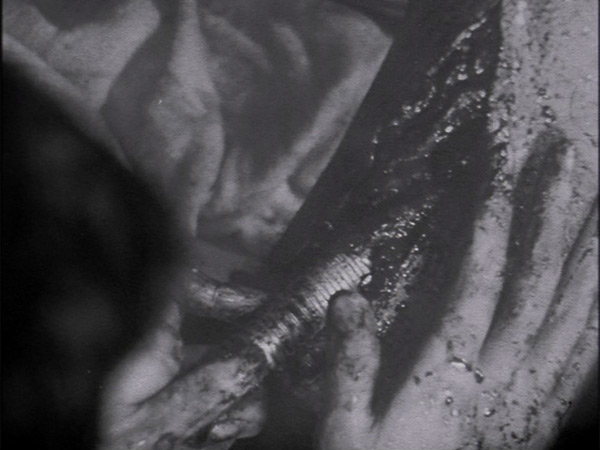
I can’t convey how truly disgusting this scene comes across
On a personal level, Tetsuo explores how guilt and repression can turn people into virtual "monsters." In this, we see an instance where an accidental car crash makes someone completely lose all sense of humanity and boundaries. This seems to fit with Asian cultures in that they are usually very reserved, but when they "cross" that line, the level of anger and craziness almost doesn’t have a limiter.
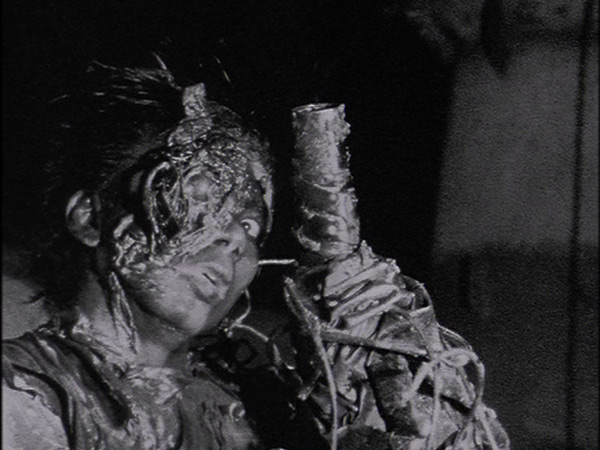
In combining this with the societal thought, Tetsuo posits that we are using technology as a crutch to cover up our own frailties, but that in doing so, we only serve to subvert our humanity. When this subversion is released, it becomes a perversion of immense proportions. In this sense, Tetsuo truly stretches the cyberpunk notion of "no boundaries" to its fullest.
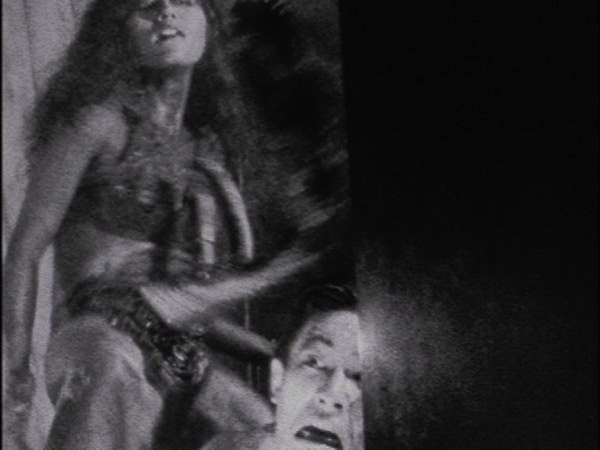
Yes, she’s about to do what you "think" she’s planning to do with that thing!"
The Bottom Line: Tetsuo is a great example of what a low-budget scifi film can accomplish. I thought the cinematography is absolutely brilliant. We get cool stop-motion animation, incredibly interesting shadows and film angles, and wonderful use of different shot textures. The industrial sound track furthers the truly bizarre mood. Truly, I can’t say enough of how impressed I am by this film. Again, Tetsuo is DEFINITELY not for everyone, but it certainly belongs in the top 10 best cyberpunk films ever made!
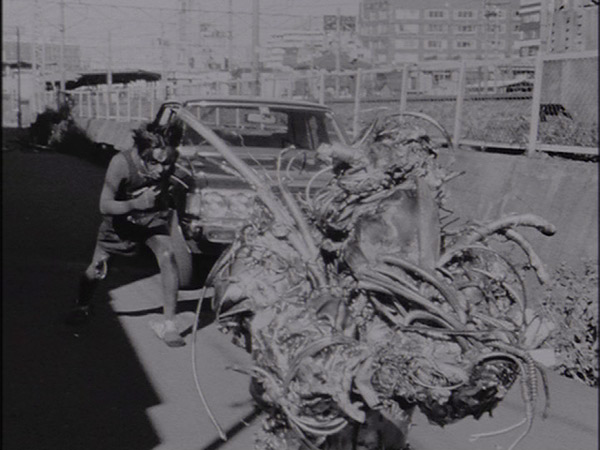
Screen Captures - ADULTS ONLY: I do have a second page of screen captures, but I MUST warn you - these are VERY graphic. They show one of the most intense sex and violence scenes every put on film. If you want to get a sense of he the extent that Japanese cyberpunk fullfills its “no boundaries” approach, take a look. But this page is intended for adults - and truly, only a few select few of those. Don’t look if you’re not comfortable with watching these things.
Tetsuo Page 2: Screen Caps - ADULTS ONLY–>>
Year: 2004
Directed by: Mamoru Oshii
Written by: Shirow Masamune (Comic), Mamoru Oshii (Screenplay)
IMDB Reference
Degree of Cyberpunk Visuals: Very High
Correlation to Cyberpunk Themes: Very High
Overview: If you’re looking for the best instance of awesome 2D-3D anime with an incredible philosophically laden story, Ghost in the Shell: Innocence is the hands down winner. While I still like Wonderful Days more on pure cinematography, it doesn’t hold a candle on either the story or the philosophy. Oshii is truly a master at providing an incredibly intricate, fully researched message about the direction of humanity in a wonderful anime package. Make no mistake - Oshii is fully up on co-evolution theory (the co-evolution of man and his tools) and has something very interesting to add to the discussion. And while it has all of this, GITS:2 does suffer overtly and purposefully from the absence of its star character - Motoko.
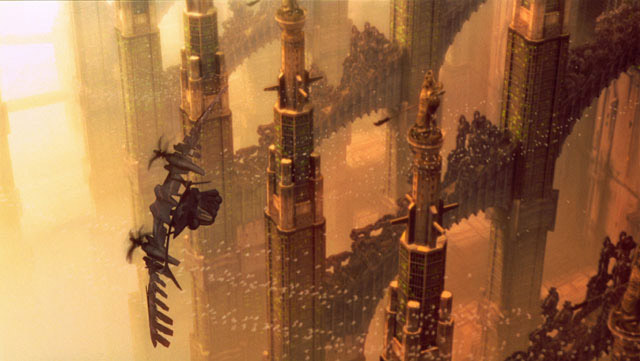
Major Motoko, the main character from the first Ghost in the Shell movie (which might still make an appearance here…) is no longer here, and the rest of the cast has to pick up the pieces and move on. Bateau (Ôtsuk), major motoko’s partner from the first movie, and a cyborg detective for the anti-terrorist unit Public Security Section 9, investigates the case of a female robot - one created solely for sexual pleasure - who slaughtered her owner. Togusa, the mostly human detective that Motoko found in Ghost 1 is assigned as Bateau’s partner. The plot thickens as the movie progresses, and the two are sent to a number of incredibly cyberpunk looking locations to uncover the truth.
Overall, this movie has the feeling of a cast trying to cope when the major star has left. Similar to the Borg Encounter when Picard is removed, or maybe some of the first star trek series when Captain Kirk is lost somewhere doing green chicks, Motoko’s disappearance dominates a most of the back story. We get to see almost a character study of Bateau, a mostly cyborg being who has suffered the loss of the closest person alive to him struggle to maintain meaning in his life
and Togusa failing to live up to Bateau’s expectations as a partner. While the characters are able to work fine within the plot, the movie suffers from the lack of both sex appeal and the lack of a truly dominant character.
Similar to other Oshii films, there are instances where the plot gets put on hold to allow the philosophy to explored. This is a different sort of pacing (again copied by the matrix) which some like and others find pretentious (I like it!). The philosophy breaks are interesting, but only get fully connected at the end. Additionally, the plot is twisting enough and only clarified in the end that a second viewing would aid in comprehension.
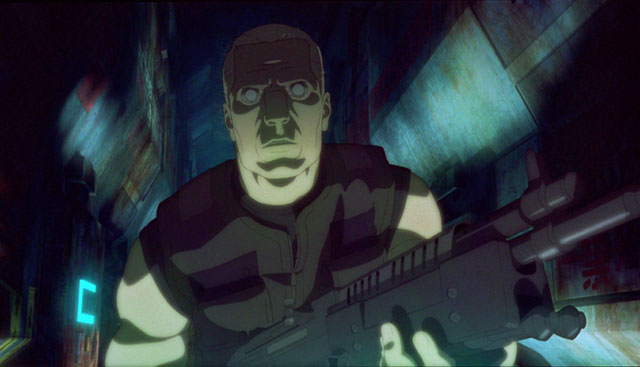
Even if you don’t like the metaphysical mumbo-jumbo or strange pacing, Ghost 2 should be seen as mandatory viewing for its truly mind blowing merging of computer imagery and hand drawn animation artistry. This is cyberpunk at its finest! Truly, Neuromancer’s William Gibson would be floored with the continually awe-inspiring scenery that’s intermixed with the grittiest of settings. I lost count of the number of sets I would have loved to freeze and place on my wall. From the creation of robots complete with fiber optic circuitry and positronic brains, to the dingy alleys of the underworld, the vast expanses of the futuristic building-scapes, this movie employs every color palette in the most effective manner imaginable. Often, you almost stop paying attention to the subtitles to just take in the scene in all its heavenly glory.
On top of this, we get trademark moments of Oshii pacing. Oshii is fully content to leave the dialogue aside for a while and let the mood develop from the visuals and sound. Very few movies do this effectively - Avalon and GITS:2 certainly come to the top of the list. In short, the pacing makes GITS:2 a fully immersive experience in a way that visuals alone couldn’t do.
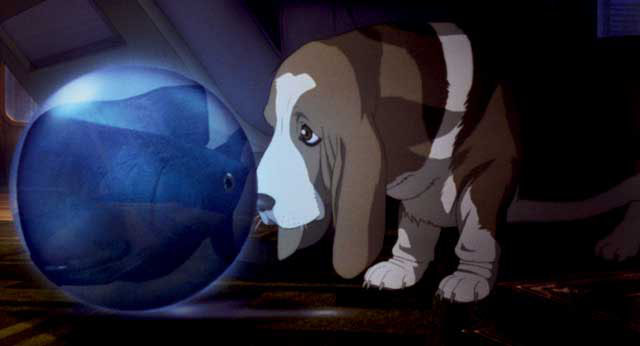
GITS 2 Philosophy: In looking at the philosophy, the first Ghost was dominated by a discussion of what it means to be human and being alive. It culminated in the creation of a new species - the merging of a sentient program called the puppet master with Motoko, an alive human complete with a soul (ghost). Without knowing the details of Ghost 2, one would have expected in seeing the first movie that Oshii would have explored this vast new experience in Ghost 2, Yet this was not to be, as instead the story takes a very different perspective to the ideas covered in the first movie. Innocence is really tracing the idea that what we "see" isn’t at all real, and that reality as a concept needs significant revision. This is done in a variety of ways through mirror analogies, VR segments and discussions of whether there is a difference between artificial life and real life. In this sense, GITS2 is far more the philosophical sequel to Avalon.
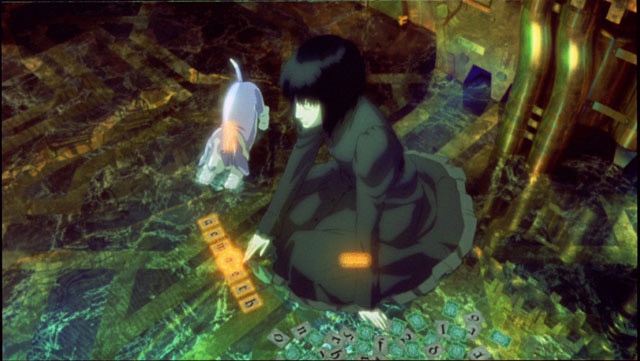
Ghost 2 almost turns the perspective from Ghost one on its head and looks at what it means to be a sentient program and how even humans seeking to become fully cyborg struggle to attain this plateau of ever increasing sensory perception and understanding. Taking Decarte’s notion ("I think, therefore, I am") that sentient life does not require a ghost, Ghost 2 explores the notion that a sentient program or robot (called a "doll") might NOT want to have a ghost, and looks at what happens when ghosts are foisted on dolls. Ideas taken for granted in the real world, like the demarcation between life and death get blended and rendered almost meaningless.
On Dolls: Let’s go into a discussion of dolls for a moment: On one hand, dolls in our terms are purely fake, but in the eyes of a child, are actually "real" in the sense that they are assigned virtual persona and as an object and affect the behavior of the child. In effect, the notion of the child’s mind being constrained to her head is challenged - the child’s mind functions "virtually" in the doll. This notion of a doll is also examined in the sense that it contains our greatest fears - that all we are is a "shell" without something actually unique inside that makes us special. In making a cyborg "doll" that mimics a human - GITS2 poses that we are creating a human-looking shell that is sentient in the Descartes sense, but is not complete. Even worse, when given a facsimile of a ghost, we are doing real harm to the doll as the doll is now neither a stable sentient robot nor a human, but a bastardized thing in-between.
In total, there is this ongoing discussion of three types of "ultimate" life forms: God, Dolls, and animals. They all embody the notion of innocence. God (in this sense, almost synonymous with Major Motoko’s new form) is all knowing so basic human frailties no longer affect her. Needs and desires that humans have are non-existent for God. Dolls, and in cyborg version of dolls - sentient robots, are also perfect in that they can think but don’t fall prey to human inadequacies. Finally, Oshii argues animals such as dogs are innocent. Their joys in life are simple ones - Batou’s dog scenes also serve to demonstrate that which is still "human" about Batou - everything else in his life has been rendered meaningless. In this sense, interestingly the dog takes on the same roll as a doll does with a child - This shows Batou’s mind expressing its "virtual" humanity externally.
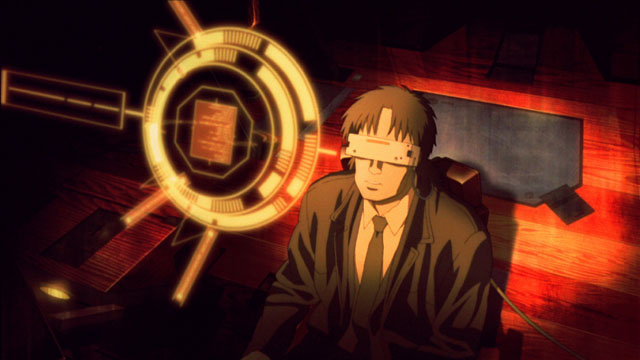
Throughout the movie are instances of humanity’s self-gratification, extreme self-importance and the consequences of over-indulgence. From the enormous cathedrals to the dingy alleyways, to the making of dolls in our own “perfect” shell of ourselves, Oshii’s message is that we are doing everything possible to hide ourselves from true humanity. The beautiful imagery of GITS 2 is the result. Freedom comes not through materialism, but through real “humanity.” However, one wonders whether Oshii thinks real humanity is in anyway restricted to humans. At some level Oshii is saying our bodies are now obsolete, and that what makes us human, our shell, may not be the purview of humans.
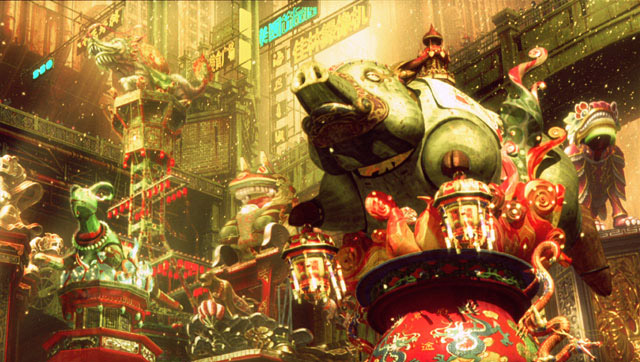
As for the details of the merging of traditional hand drawn animation, there are a few scenes where the Babylon 5-like ships or statues don’t quite fit, but for the most part, the expansive scenes have incredible depth, and the close-ups are as exquisite as a portrait. You are truly missing out on a feat of artistic beauty if pass this movie up. And overall, GITS:2 is clearly in of the best new cyberpunk movies out. Watch it - you won’t be disappointed.
~See movies similar to this one~
Tags: cyberpunk movie review
|










































